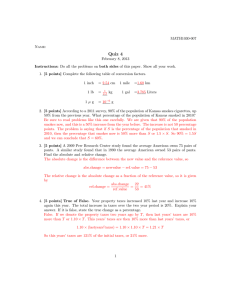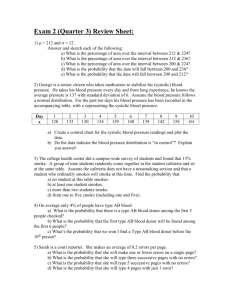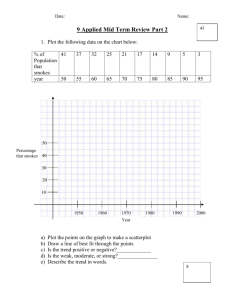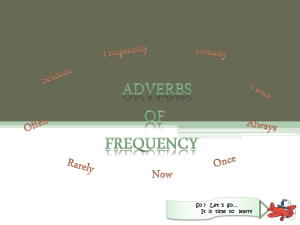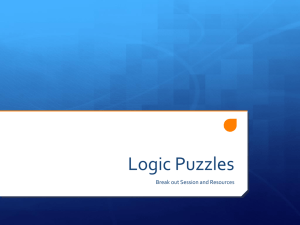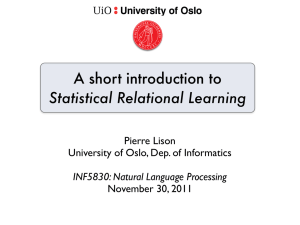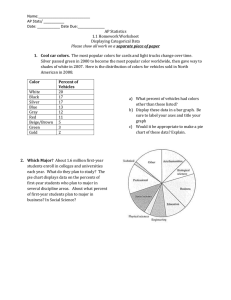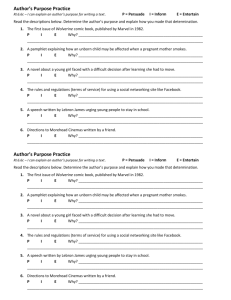MLN Slides
advertisement
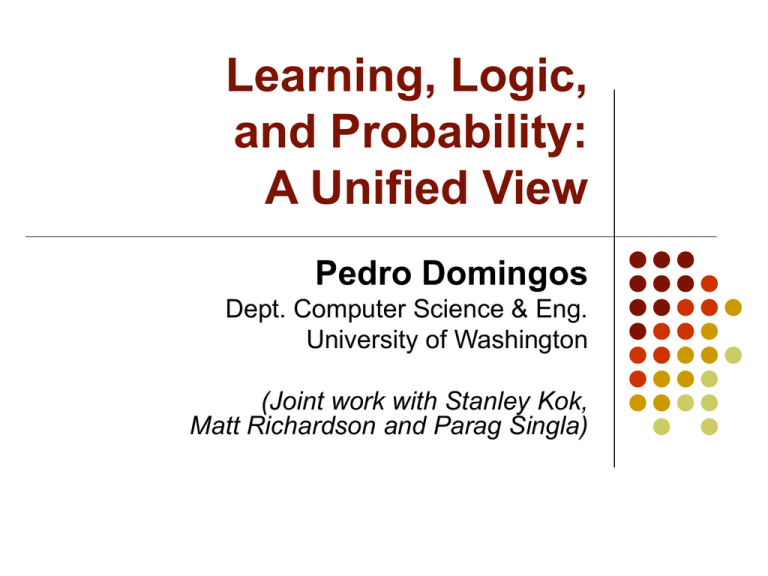
Learning, Logic, and Probability: A Unified View Pedro Domingos Dept. Computer Science & Eng. University of Washington (Joint work with Stanley Kok, Matt Richardson and Parag Singla) Overview Motivation Background Markov logic networks Inference in MLNs Learning MLNs Experiments Discussion The Way Things Were First-order logic is the foundation of computer science Problem: Logic is too brittle Programs are written by hand Problem: Too expensive, not scalable The Way Things Are Probability overcomes the brittleness Machine learning automates programming Their use is spreading rapidly Problem: For the most part, they apply only to vectors What about structured objects, class hierarchies, relational databases, etc.? The Way Things Will Be Learning and probability applied to the full expressiveness of first-order logic This talk: First approach that does this Benefits: Robustness, reusability, scalability, reduced cost, human-friendliness, etc. Learning and probability will become everyday tools of computer scientists Many things will be practical that weren’t before State of the Art Learning: Decision trees, SVMs, etc. Logic: Resolution, WalkSat, Prolog, description logics, etc. Probability: Bayes nets, Markov nets, etc. Learning + Logic: Inductive logic prog. (ILP) Learning + Probability: EM, K2, etc. Logic + Probability: Halpern, Bacchus, KBMC, PRISM, etc. Learning + Logic + Probability Recent (last five years) Workshops: SRL [‘00, ‘03, ‘04], MRDM [‘02, ‘03, ‘04] Special issues: SIGKDD, Machine Learning All approaches so far use only subsets of first-order logic Horn clauses (e.g., SLPs [Cussens, 2001; Muggleton, 2002]) Description logics (e.g., PRMs [Friedman et al., 1999]) Database queries (e.g., RMNs [Taskar et al., 2002]) Questions Is it possible to combine the full power of first-order logic and probabilistic graphical models in a single representation? Is it possible to reason and learn efficiently in such a representation? Markov Logic Networks Syntax: First-order logic + Weights Semantics: Templates for Markov nets Inference: KBMC + MCMC Learning: ILP + Pseudo-likelihood Special cases: Collective classification, link prediction, link-based clustering, social networks, object identification, etc. Overview Motivation Background Markov logic networks Inference in MLNs Learning MLNs Experiments Discussion Markov Networks Undirected graphical models A B C D Potential functions defined over cliques 1 Z c ( X ) P( X ) c ( X ) Z c X c ( A, B) 3.7 if A and B 2.1 if A and B 0.7 otherwise 2.3 if B and C and D ( B, C , D ) 5.1 otherwise Markov Networks Undirected graphical models A B C D Potential functions defined over cliques 1 P( X ) exp wi f i ( X ) Z i Weight of Feature i Feature i f ( A, B ) Z exp wi f i ( X ) X i 1 if A and B 0 otherwise 1 if B and C and D f ( B, C , D ) 0 First-Order Logic Constants, variables, functions, predicates E.g.: Anna, X, mother_of(X), friends(X, Y) Grounding: Replace all variables by constants E.g.: friends (Anna, Bob) World (model, interpretation): Assignment of truth values to all ground predicates Example of First-Order KB Smoking causes cancer Friends either both smoke or both don’t smoke Example of First-Order KB x Smokes( x ) Cancer ( x ) x, y Friends ( x, y ) Smokes( x ) Smokes( y ) Overview Motivation Background Markov logic networks Inference in MLNs Learning MLNs Experiments Discussion Markov Logic Networks A logical KB is a set of hard constraints on the set of possible worlds Let’s make them soft constraints: When a world violates a formula, It becomes less probable, not impossible Give each formula a weight (Higher weight Stronger constraint) P(world ) exp weights of formulas it satisfies Definition A Markov Logic Network (MLN) is a set of pairs (F, w) where F is a formula in first-order logic w is a real number Together with a set of constants, it defines a Markov network with One node for each grounding of each predicate in the MLN One feature for each grounding of each formula F in the MLN, with the corresponding weight w Example of an MLN 1.5 x Smokes( x ) Cancer ( x ) 1.1 x, y Friends ( x, y ) Smokes( x ) Smokes( y ) Suppose we have two constants: Anna (A) and Bob (B) Smokes(A) Cancer(A) Smokes(B) Cancer(B) Example of an MLN 1.5 x Smokes( x ) Cancer ( x ) 1.1 x, y Friends ( x, y ) Smokes( x ) Smokes( y ) Suppose we have two constants: Anna (A) and Bob (B) Friends(A,B) Friends(A,A) Smokes(A) Smokes(B) Cancer(A) Friends(B,B) Cancer(B) Friends(B,A) Example of an MLN 1.5 x Smokes( x ) Cancer ( x ) 1.1 x, y Friends ( x, y ) Smokes( x ) Smokes( y ) Suppose we have two constants: Anna (A) and Bob (B) Friends(A,B) Friends(A,A) Smokes(A) Smokes(B) Cancer(A) Friends(B,B) Cancer(B) Friends(B,A) Example of an MLN 1.5 x Smokes( x ) Cancer ( x ) 1.1 x, y Friends ( x, y ) Smokes( x ) Smokes( y ) Suppose we have two constants: Anna (A) and Bob (B) Friends(A,B) Friends(A,A) Smokes(A) Smokes(B) Cancer(A) Friends(B,B) Cancer(B) Friends(B,A) More on MLNs Graph structure: Arc between two nodes iff predicates appear together in some formula MLN is template for ground Markov nets Typed variables and constants greatly reduce size of ground Markov net Functions, existential quantifiers, etc. MLN without variables = Markov network (subsumes graphical models) MLNs Subsume FOL Infinite weights First-order logic Satisfiable KB, positive weights Satisfying assignments = Modes of distribution MLNs allow contradictions between formulas How to break KB into formulas? Adding probability increases degrees of freedom Knowledge engineering decision Default: Convert to clausal form Overview Motivation Background Markov logic networks Inference in MLNs Learning MLNs Experiments Discussion Inference Given query predicate(s) and evidence 1. Extract minimal subset of ground Markov network required to answer query 2. Apply probabilistic inference to this network (Generalization of KBMC [Wellman et al., 1992]) Grounding the Template Initialize Markov net to contain all query preds For each node in network Add node’s Markov blanket to network Remove any evidence nodes Repeat until done Example Grounding 1.5 x Smokes( x ) Cancer ( x ) 1.1 x, y Friends ( x, y ) Smokes( x ) Smokes( y ) Friends(A,B) Friends(A,A) Smokes(A) Smokes(B) Cancer(A) Friends(B,B) Cancer(B) Friends(B,A) P( Cancer(B) | Smokes(A), Friends(A,B), Friends(B,A)) Example Grounding 1.5 x Smokes( x ) Cancer ( x ) 1.1 x, y Friends ( x, y ) Smokes( x ) Smokes( y ) Friends(A,B) Friends(A,A) Smokes(A) Smokes(B) Cancer(A) Friends(B,B) Cancer(B) Friends(B,A) P( Cancer(B) | Smokes(A), Friends(A,B), Friends(B,A)) Example Grounding 1.5 x Smokes( x ) Cancer ( x ) 1.1 x, y Friends ( x, y ) Smokes( x ) Smokes( y ) Friends(A,B) Friends(A,A) Smokes(A) Smokes(B) Cancer(A) Friends(B,B) Cancer(B) Friends(B,A) P( Cancer(B) | Smokes(A), Friends(A,B), Friends(B,A)) Example Grounding 1.5 x Smokes( x ) Cancer ( x ) 1.1 x, y Friends ( x, y ) Smokes( x ) Smokes( y ) Friends(A,B) Friends(A,A) Smokes(A) Smokes(B) Cancer(A) Friends(B,B) Cancer(B) Friends(B,A) P( Cancer(B) | Smokes(A), Friends(A,B), Friends(B,A)) Example Grounding 1.5 x Smokes( x ) Cancer ( x ) 1.1 x, y Friends ( x, y ) Smokes( x ) Smokes( y ) Friends(A,B) Friends(A,A) Smokes(A) Smokes(B) Cancer(A) Friends(B,B) Cancer(B) Friends(B,A) P( Cancer(B) | Smokes(A), Friends(A,B), Friends(B,A)) Example Grounding 1.5 x Smokes( x ) Cancer ( x ) 1.1 x, y Friends ( x, y ) Smokes( x ) Smokes( y ) Friends(A,B) Friends(A,A) Smokes(A) Smokes(B) Cancer(A) Friends(B,B) Cancer(B) Friends(B,A) P( Cancer(B) | Smokes(A), Friends(A,B), Friends(B,A)) Example Grounding 1.5 x Smokes( x ) Cancer ( x ) 1.1 x, y Friends ( x, y ) Smokes( x ) Smokes( y ) Friends(A,B) Friends(A,A) Smokes(A) Smokes(B) Cancer(A) Friends(B,B) Cancer(B) Friends(B,A) P( Cancer(B) | Smokes(A), Friends(A,B), Friends(B,A)) Example Grounding 1.5 x Smokes( x ) Cancer ( x ) 1.1 x, y Friends ( x, y ) Smokes( x ) Smokes( y ) Friends(A,B) Friends(A,A) Smokes(A) Smokes(B) Cancer(A) Friends(B,B) Cancer(B) Friends(B,A) P( Cancer(B) | Smokes(A), Friends(A,B), Friends(B,A)) Example Grounding 1.5 x Smokes( x ) Cancer ( x ) 1.1 x, y Friends ( x, y ) Smokes( x ) Smokes( y ) e 2.2 if Smokes(B) Friends(A,B) 0 e otherwise Friends(A,A) Smokes(A) Smokes(B) e1.5Cancer(A) if Smokes(B) Cancer ( B ) 0 Friends(B,A) e otherwise Friends(B,B) Cancer(B) P( Cancer(B) | Smokes(A), Friends(A,B), Friends(B,A)) Probabilistic Inference Recall P( X ) 1 exp wi f i ( X ) Z i Z exp wi f i ( X ) X i Exact inference is #P-complete Conditioning on Markov blanket is easy: w f ( x) P( x | MB( x )) exp w f ( x 0) exp w f ( x 1) exp i i i i Gibbs sampling exploits this i i i i i Markov Chain Monte Carlo Gibbs Sampler 1. Start with an initial assignment to nodes 2. One node at a time, sample node given others 3. Repeat 4. Use samples to compute P(X) Apply to ground network Many modes Multiple chains Initialization: MaxWalkSat [Selman et al., 1996] Overview Motivation Background Markov logic networks Inference in MLNs Learning MLNs Experiments Discussion Learning Data is a relational database Closed world assumption Learning structure Corresponds to feature induction in Markov nets Learn / modify clauses Inductive logic programming (e.g., CLAUDIEN [De Raedt & Dehaspe, 1997]) Learning parameters (weights) Learning Weights Maximize likelihood (or posterior) Use gradient ascent d log P( X ) f i ( X ) EY [ f i (Y )] dwi Feature count according to data Feature count according to model Requires inference at each step (slow!) Pseudo-Likelihood [Besag, 1975] PL( X ) P( x | MB( x )) x Likelihood of each variable given its Markov blanket in the data Does not require inference at each step Very fast gradient ascent Widely used in spatial statistics, social networks, natural language processing MLN Weight Learning Parameter tying over groundings of same clause Maximize pseudo-likelihood using conjugate gradient with line minimization i nsati ( x ) p( x 0)nsati ( x 0) p( x 1)nsati ( x 1) x where nsati(x=v) is the number of satisfied groundings of clause i in the training data when x takes value v Most terms not affected by changes in weights After initial setup, each iteration takes O(# ground predicates x # first-order clauses) Overview Motivation Background Markov logic networks Inference in MLNs Learning MLNs Experiments Discussion Domain University of Washington CSE Dept. 24 first-order predicates: Professor, Student, TaughtBy, AuthorOf, AdvisedBy, etc. 2707 constants divided into 11 types: Person (400), Course (157), Paper (76), Quarter (14), etc. 8.2 million ground predicates 9834 ground predicates (tuples in database) Systems Compared Hand-built knowledge base (KB) ILP: CLAUDIEN [De Raedt & Dehaspe, 1997] Markov logic networks (MLNs) Using KB Using CLAUDIEN Using KB + CLAUDIEN Bayesian network learner [Heckerman et al., 1995] Naïve Bayes [Domingos & Pazzani, 1997] Sample Clauses in KB Students are not professors Each student has only one advisor If a student is an author of a paper, so is her advisor Advanced students only TA courses taught by their advisors At most one author of a given paper is a professor Methodology Data split into five areas: AI, graphics, languages, systems, theory Leave-one-area-out testing Task: Predict AdvisedBy(x, y) All Info: Given all other predicates Partial Info: With Student(x) and Professor(x) missing Evaluation measures: Conditional log-likelihood (KB, CLAUDIEN: Run WalkSat 100x to get probabilities) Area under precision-recall curve Results System All Info CLL Area MLN(KB+CL) -0.044 0.27 Partial Info CLL Area -0.040 0.25 MLN(KB) MLN(CL) KB CL NB BN -0.043 -0.852 -0.067 -0.371 -0.059 -0.166 -0.047 -0.341 -0.124 -0.255 -0.218 -0.095 0.25 0.02 0.16 0.03 0.17 0.02 0.20 0.03 0.08 0.04 0.19 0.04 Results: All Info Results: Partial Info Efficiency Learning time: 88 mins Time to infer all 4900 AdvisedBy predicates: With complete info: 23 mins With partial info: 24 mins (10,000 samples) Overview Motivation Background Markov logic networks Inference in MLNs Learning MLNs Experiments Discussion Related Work Knowledge-based model construction [Wellman et al., 1992; etc.] Stochastic logic programs [Muggleton, 1996; Cussens, 1999; etc.] Probabilistic relational models [Friedman et al., 1999; etc.] Relational Markov networks [Taskar et al., 2002] Etc. Special Cases of Markov Logic Collective classification Link prediction Link-based clustering Social network models Object identification Etc. Future Work: Inference Lifted inference Better MCMC (e.g., Swendsen-Wang) Belief propagation Selective grounding Abstraction, summarization, multi-scale Special cases Etc. Future Work: Learning Faster optimization Beyond pseudo-likelihood Discriminative training Learning and refining structure Learning with missing info Learning by reformulation Etc. Future Work: Applications Object identification Information extraction & integration Natural language processing Scene analysis Systems biology Social networks Assisted cognition Semantic Web Etc. Conclusion Computer systems must learn, reason logically, and handle uncertainty Markov logic networks combine full power of first-order logic and prob. graphical models Syntax: First-order logic + Weights Semantics: Templates for Markov networks Inference: MCMC over minimal grounding Learning: Pseudo-likelihood and ILP Experiments on UW DB show promise
